101 years ago today, one of the standout dates on the motorsport calendar, the 24 Hours of Le Mans, held its inaugural event. Le Mans is one of the races—along with the Monaco Grand Prix and Indianapolis 500—that form the Triple Crown of Motorsport, and is the oldest active endurance racing event on Earth. The 24 Hours of Le Mans is won by the car that covers the greatest distance in 24 hours. Thus, racing teams must balance the demands of speed with the cars’ ability to run for 24 hours without mechanical failure. READ more about this famous event… (1923)
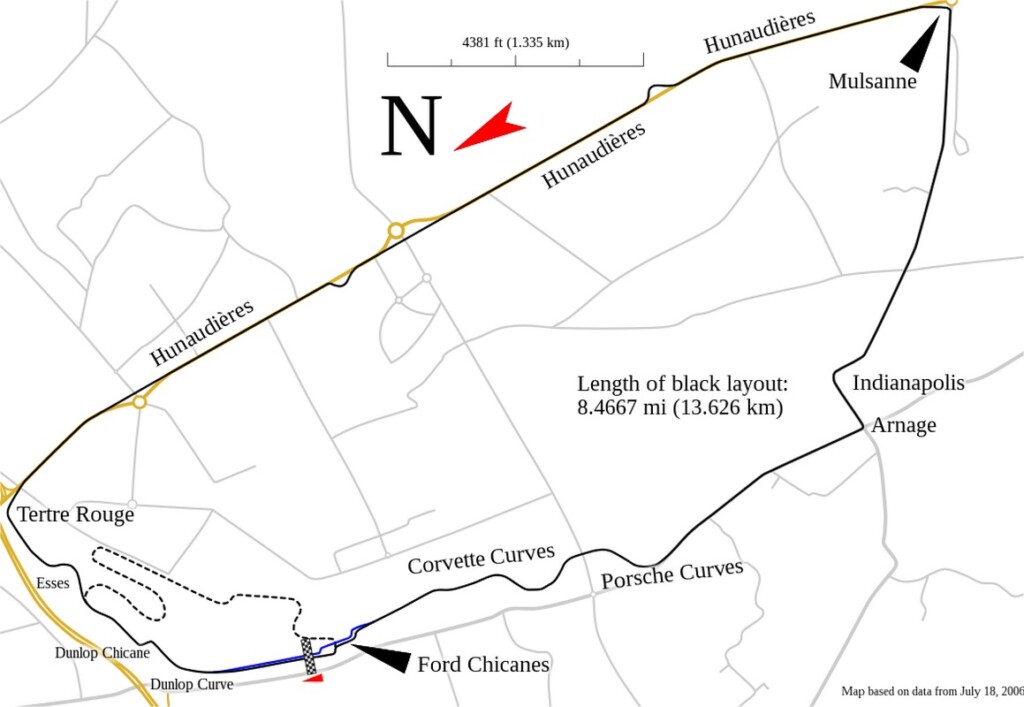
The cars on this track used to be able to achieve speeds of 366 km/h (227 mph), and in fact, reached 407 km/h (253 mph) on the Mulsanne Straight in 1988, which instigating the addition of more chicanes to the track to reduce speed and risk of disaster, such as one in which a collision sent a car flying into the spectators stand.
The early races were dominated by French, British, and Italian drivers, teams, and cars, with Bugatti, Bentley, and Alfa Romeo being the top brands. Innovations in car design began appearing at the track in the late 1930s. After World War II, through and either side of which the race saw a 10-year hiatus, Ferrari came into a famous period of dominance that saw the company win 4 straight events, ended only by Ford with the GT40.
The 70s and 80s saw a period of dominance by Porsche, interrupted by back-to-back wins by Jaguar, before the emergence of the Japanese racing teams. The new millennium was dominated by Audi, for which Danish driver Tom Kristensen became the most successful participant of all time at Le Mans, winning 7 with the German brand and another 2 outside them.
Early on, the 24 Hours of Le Mans was started by the famous ‘standing start’ in which the drivers would stand on a line meters from their cars and had to run, board, and turn them on before they could set off. Now, a rolling start, pioneered in the Indianapolis 500, is employed.
MORE Good News on this Day:
- A Great Jubilee Day was held in Trumbull, Connecticut to celebrate the end of the American Revolution (1783)
- Jazz trumpeter and composer Miles Davis, one of the most influential and innovative musicians of the 20th century, who broke long-held musical rules and helped popularize jazz fusion with his 4-time platinum 1959 album, Kind of Blue, was born (1926)
- English actress Helena Bonham Carter, 54, (The King’s Speech, Fight Club, Harry Potter), was born (1966)
- British Guiana gains independence, becoming Guyana (1966)
- The Anti-Ballistic Missile Treaty was signed by the United States (Nixon) and the Soviet Union (Brezhnev), which was in force for thirty years — until 2002 when the US withdrew to pursue a Missile Defense System (1972)
- Faced with Mott The Hoople splitting up, David Bowie offered the band two of his new songs, Suffragette City (which they turned down), and All The Young Dudes, which became a huge hit for the group—rising to No.3 in the UK and into the Top 40 in the US (1972)
- The Edgar Winter Group went to No.1 on the US singles chart with Frankenstein, with Winter playing a protracted solo with a then-innovative synthesizer, becoming the first person ever to strap a keyboard instrument around his neck (1973)
- For the first time ever the top five positions on the US singles chart were held by female artists; Madonna was at No.1 with ‘Vogue’, Heart at No.2, Sinead O’Connor at No.3, and Wilson Phillips and Janet Jackson at 4 and 5. (1990)
- Federal judge Sonia Sotomayor was nominated to be the first Hispanic justice on the Supreme Court by President Barack Obama (2009)
111 years ago, Peter Cushing was born. The British actor became best known as the go-to man to portray lead human roles in more than 2 dozen horror films produced by Hammer Films, including Dracula, and Doctor Frankenstein both on several occasions. He is remembered among the younger generations undoubtedly for his exceptional role as Grand Moff Tarkin in Star Wars, Darth Vader’s military-commander collaborator. Cushing was known among his colleagues for his gentle and gentlemanly demeanor, as well as his professionalism and rigorous preparation as an actor. His co-stars and colleagues often spoke of his politeness, charm, old-fashioned manners, and sense of humor.
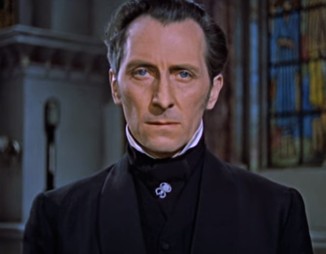
Cushing had a voracious interest in miniature wargaming. His tabletop model soldier collection for the game exceeded 5,000 models, all of which he hand-painted himself. He used the rule set written by H.G. Wells for wargaming. He also loved watercolor painting.
A passage in his Wikipedia bio should serve as inspiration to would-be actors today.
Cushing eventually applied for a scholarship at the Guildhall School of Music and Drama in London. His first audition was before the actor Allan Aynesworth, who was so unimpressed with Cushing’s manner of speech that he rejected him outright and insisted he not return until he improved his diction. Cushing continued to pursue a scholarship, writing twenty-one letters to the school until actor and theatre manager Bill Fraser finally agreed to meet Cushing in 1935 simply so he could ask him in person to stop writing.
During that meeting, Cushing was given a walk-on part as a courier in that night’s production of J.B. Priestley’s Cornelius. This marked his professional stage debut, although he had no lines and did little more than stand on stage behind other actors. Afterward, he was granted the scholarship and given odd jobs around the theatre, such as selling refreshments and working as an assistant stage manager. (1913)
And, 57 years ago today, arguably the greatest album ever, was released. Sgt. Pepper’s Lonely Hearts Club Band sat at number 1 on the UK Albums Chart for 27 weeks, selling 2.5 million copies in the first three months, and 32 million to date. It was lauded by critics for its innovations in songwriting, production, and graphic design, for bridging a cultural divide between popular music and high art, and for reflecting the interests of contemporary youth and the counterculture.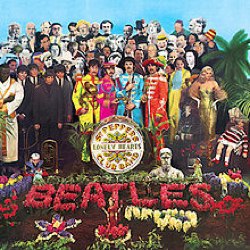
Paul McCartney said:
“We were fed up with being the Beatles. We really hated that fucking four little mop-top approach. We were not boys, we were men… and thought of ourselves as artists rather than just performers.”
Rolling Stone magazine’s Langdon Winner recalled:
“The closest Western Civilization has come to unity since the Congress of Vienna in 1815 was the week the Sgt. Pepper album was released. In every city in Europe and America the radio stations played… and everyone listened.”
Stephen Thomas Erlewine of AllMusic said:
“Not once does the diversity seem forced. After Sgt. Pepper, there were no rules to follow – rock and pop bands could try anything, for better or worse.”
Author Jonathan Gould wrote that Sgt. Pepper was:
“The catalyst for an explosion of mass enthusiasm for album-formatted rock that would revolutionize both the aesthetics and the economics of the record business in ways that far out-stripped the earlier pop explosions triggered by the Elvis phenomenon of 1956 and the Beatlemania phenomenon of 1963.” (1967)
68 years ago today The Silent World (Le Monde du Silence), the French documentary co-directed by famed oceanographer Jacques Cousteau and a young filmmaker, Louis Malle, was released.

Noted as one of the first films to use underwater cinematography to show the ocean depths in color, it won the Palme d’Or award at the Cannes Film Festival, the only documentary to do so for nearly 50 years. WATCH the mesmerizing opening shot sequence, and more… (1956)
And, 106 years ago today, the Democratic Republic of Georgia was established after the collapse of the Russian empire.

The three years of Georgian independence were a catalyst for the development of a national feeling among the people, a major factor that made the country one of the most active “independist” forces within the Soviet Union. In the post-Soviet era the first President of Georgia was democratically elected on this day in 1991, National Independence Day. (1918)
On this day, 104 years ago the singer-songwriter and actress Peggy Lee was born in North Dakota. You might know her sultry voice from her 1958 hit single Fever, but she was also nominated for 12 Grammy Awards, including Best Contemporary Vocal Performance for her 1969 hit Is That All There Is. You may also know her as the voice of the Siamese Cats in Disney Lady and The Tramp.
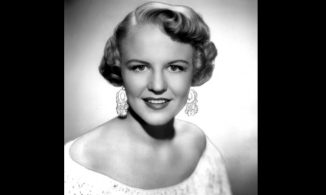
From jazz to pop, she worked with Benny Goodman, Randy Newman, and Quincy Jones in a career spanning six decades. Lee created a sophisticated persona that lent itself well to acting, but she was also a composer, writing music for films, and recording conceptual albums combining poetry and music. (1920–2002)
And 26 years ago today, Australia held its first “National Sorry Day” with reconciliation events nationwide attended by over a million people. They gathered to honor the continent’s mistreated indigenous population, particularly the children who were taken from their homes. The government officially expressed sincere regret for the injustices suffered in past generations, and “for the hurt and trauma that many indigenous people continue to feel as a consequence of those practices.” (1998)
And, on this day, in 1907, John Wayne was born in Winterset, Iowa. Nicknamed “The Duke,” Marion Robert Morrison became an instant star after his role in John Ford’s 1939 film, Stagecoach.
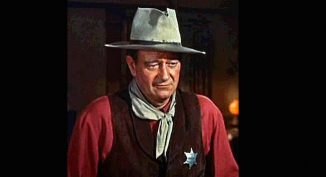 He went on to play the hero in 142 pictures, and won the Oscar for Best Actor for True Grit (1969). His voice, swagger, and charisma in action films and westerns made him a major box office draw for thirty years. Wayne’s other well-known Western roles include: a cattleman driving his herd in Red River (1948), a Civil War veteran whose young niece is abducted by a tribe of Comanches in The Searchers (1956), and a troubled rancher competing with a lawyer for a woman’s hand in marriage in The Man Who Shot Liberty Valance (1962). He is also remembered for his roles in The Quiet Man (1952), Rio Bravo (1959), and The Longest Day (1962). In his final screen performance, in The Shootist, he played an aging gunfighter battling cancer — three years before his own death in 1979 from stomach cancer at age 72.
He went on to play the hero in 142 pictures, and won the Oscar for Best Actor for True Grit (1969). His voice, swagger, and charisma in action films and westerns made him a major box office draw for thirty years. Wayne’s other well-known Western roles include: a cattleman driving his herd in Red River (1948), a Civil War veteran whose young niece is abducted by a tribe of Comanches in The Searchers (1956), and a troubled rancher competing with a lawyer for a woman’s hand in marriage in The Man Who Shot Liberty Valance (1962). He is also remembered for his roles in The Quiet Man (1952), Rio Bravo (1959), and The Longest Day (1962). In his final screen performance, in The Shootist, he played an aging gunfighter battling cancer — three years before his own death in 1979 from stomach cancer at age 72.

And, 24 years ago today, the Manchester United Football Club completed an unprecedented Treble—a triple-trophy year, winning the English Premier League, the FA Cup, and the European UEFA Champions League, becoming the first and only English club to achieve the feat. After winning no titles the previous year, 1998-99 became the most successful season in the club’s 117-year history. During the campaign, ‘Man United’ lost only five times—and had a run of 33 games unbeaten.
The team’s never-say-die attitude, along with David Beckham’s bending kicks, were keys to their success—and a dramatic comeback in the Champions League final. True to their season-long tradition of thriving in difficult situations, on May 26, Teddy Sheringham and Ole Gunnar Solskjær each scored in injury time to overturn Bayern Munich’s first-half lead to win 2-1. Tens of thousands of fans lined the streets of Manchester to welcome home the team that instantly became the world’s richest football club, and the most valuable sporting brand worldwide. (1999) WATCH the 20-year tribute…
SHARE the Milestones, Memories, and Music…




















